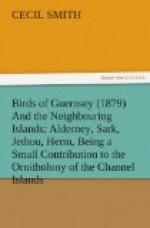eggs. On this Island there is an old deserted
cottage, sometimes used as a shelter by the lessees
of the Island, who go over there to shoot a few wretched
rabbits which pick up a precarious subsistence by
feeding on the scanty herbage; on the roof of this
cottage several of the Lesser Black-backs perched themselves
in a row whilst I was looking about at the eggs, and
kept up a most dismal screaming at the top of their
voices. The eggs, as is generally the case with
gulls, varied considerably both in ground colour and
marking; some were freckled all over with small spots—dark
brown, purple, or black; others had larger markings,
principally collected at the larger end; the ground
colour was generally blue, green, or dull olive-green.
None of the Gulls had hatched when I was there on
the 14th of June, though some of the eggs were very
hard set; and on the 29th of July I received two young
birds which had been taken on Burhou; these still had
down on them when I got them, and were then difficult
to tell from young Herring Gulls. The distinctions
I have mentioned in my note of that bird were, however,
apparent, and the slight difference in the colour of
the legs is perhaps more easily seen in the live birds
than in skins which have been kept and faded into
“Museum colour.” It is some time,
however, before either bird assumes the proper colour,
either of the legs or bill, the change being very
gradual. After the autumnal moult of 1878, however,
the dark feathers of the mantle almost entirely took
the place of the brownish feathers of the young birds;
the quills, however, have still (February, 1879) no
white tips, and the tail-feathers are still much mottled
with brown. One Lesser Black-back, which I shot
near the Vale Church on the 17th of July, 1866, is
perhaps worthy of note as being in transition, and
perhaps a rather abnormal state of change considering
the time of year at which it was shot; it was in a
full state of moult; the new feathers on the head,
neck, tail-coverts, and under parts are white; the
tail also is white, except four old feathers, two
on each side not yet moulted, which are much mottled
with brown. The primary quills had not been moulted,
and are quite those of the immature bird, with no
white tip whatever. All the new feathers of the
back and wing-coverts are the dark slate-grey of the
adult, but the old worn feathers are the brownish
feathers of the young bird; these feathers are much
worn and faded, being a paler brown than is usual in
young birds. The legs and bill are also quite
as much in a state of change as the rest of the bird.
Before finishing this notice of the Lesser Black-back
I think it is worth while to notice that it selects
quite a different sort of breeding-place to the Herring
Gull; the nests are never placed on ledges on the
steep precipitous face of the cliffs, but amongst the
bracken and the flat rocks, as at Burhou, the only
rather steep rock I have seen any nests on was at
the Amfrocques, but there they were on the flattish
top of the rock, and not on ledges on the side.




